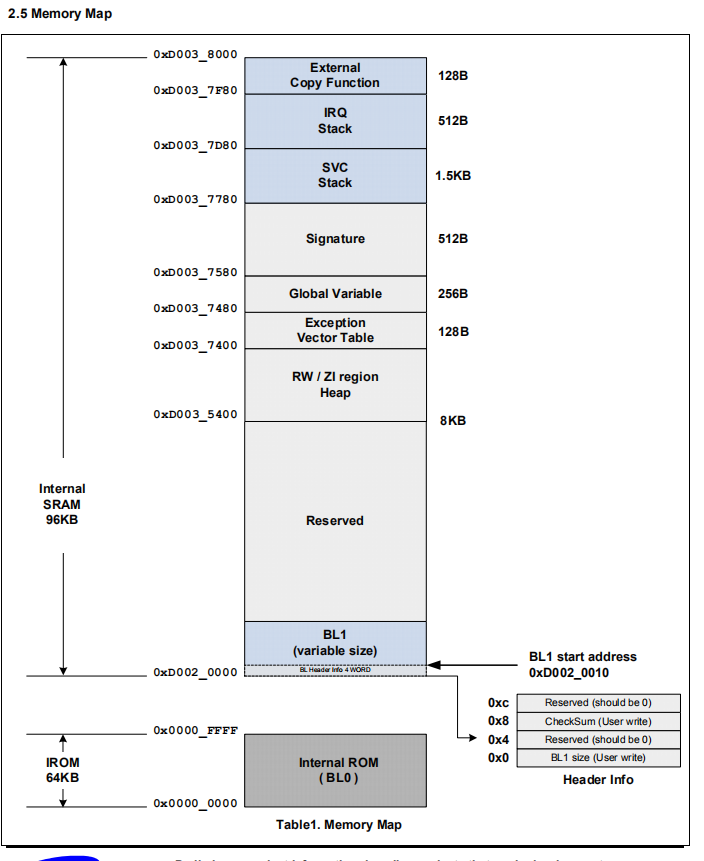一. uboot第一阶段初识
1.1. 什么是uboot第一阶段
1.1.1. 启动os三个阶段
1.1.1.1. bl0阶段
a. 这段代码是三星固化到iROM中,可以查看《S5PV210_iROM_ApplicationNote_Preliminary_20091126.pdf》
b. 这段代码作用是将uboot第一阶段的8kb加载到iRAM中

1.1.1.2. bl1阶段(uboot第一阶段)
a. 此部分是整个uboot的前8k部分
b. 此部分有bl0 加载到iRAM指定地址
1.1.1.3. bl2阶段(整个uboot)
a. 此部分是整个uboot
b. 此部分由bl1重定位到DDR的链接地址去
1.2. 第一阶段主要作用
a. 初始化DDR
b. 将整个uboot重定位到DDR中
c. 跳转到DDR中执行uboot(长跳转)
二. uboot 第一阶段源码分析
2.1. uboot链接脚本分析
a. ENTRY(_start):整个程序的入口取决于链接脚本中ENTRY声明的地方。ENTRY(_start)因此_start符号所在的文件就是整个程序的起始文件,_start所在处的代码就是整个程序的起始代码。
b. 在text段中,指定很多文件的段靠前存放,这样可以保证必要的文件可以在uboot前8K地址内

OUTPUT_FORMAT("elf32-littlearm", "elf32-littlearm", "elf32-littlearm") /*OUTPUT_FORMAT("elf32-arm", "elf32-arm", "elf32-arm")*/ OUTPUT_ARCH(arm) ENTRY(_start) SECTIONS { . = 0x00000000; . = ALIGN(4); .text : { cpu/s5pc11x/start.o (.text) cpu/s5pc11x/s5pc110/cpu_init.o (.text) board/samsung/x210/lowlevel_init.o (.text) cpu/s5pc11x/onenand_cp.o (.text) cpu/s5pc11x/nand_cp.o (.text) cpu/s5pc11x/movi.o (.text) common/secure_boot.o (.text) common/ace_sha1.o (.text) cpu/s5pc11x/pmic.o (.text) *(.text) } . = ALIGN(4); .rodata : { *(.rodata) } . = ALIGN(4); .data : { *(.data) } . = ALIGN(4); .got : { *(.got) } __u_boot_cmd_start = .; .u_boot_cmd : { *(.u_boot_cmd) } __u_boot_cmd_end = .; . = ALIGN(4); .mmudata : { *(.mmudata) } . = ALIGN(4); __bss_start = .; .bss : { *(.bss) } _end = .; }
2.2. start.S分析
2.2.1. 相关头文件分析
a. 有些头文件是在配置/编译过程生成的
b. 有些头文件使用了符号链接
c. 很多宏定义在x210_sd.h宏定义,但此文件被config.h所引用

#include <config.h> #include <version.h> #if defined(CONFIG_ENABLE_MMU) #include <asm/proc/domain.h> #endif #include <regs.h>
2.2.2. uboot头信息地址占位
a. 定义4个字空间占用16字节,16字节信息定义可以查看 《S5PV210_iROM_ApplicationNote_Preliminary_20091126.pdf》
b. 此处仅仅是定义并未赋有效值,有效值再制作usb启动uboot是写入(如使用sd_fusing中sd_fdisk.c文件会填充)

#if defined(CONFIG_EVT1) && !defined(CONFIG_FUSED) .word 0x2000 .word 0x0 .word 0x0 .word 0x0 #endif
2.2.3. _start汇编标号分析
2.3.1.1. 上述我们已经分析了,启动bl1时的起点就是_start
2.3.1.2. b reset为什么开始执行的第一句汇编
a. 无论是复位还是开启都属于重启,故启动先执行reset很合理
b. reset后cpu处于SVC模式,reset汇编重新设置模式也无妨

reset: /* * set the cpu to SVC32 mode and IRQ & FIQ disable */ @;mrs r0,cpsr @;bic r0,r0,#0x1f @;orr r0,r0,#0xd3 @;msr cpsr,r0 msr cpsr_c, #0xd3 @ I & F disable, Mode: 0x13 - SVC
2.2.4. 设置栈到iRAM
a. 此时DDR未初始化,但后面需要压栈出栈故此时把栈设置到iRAM
b. 栈地址使用《S5PV210_iROM_ApplicationNote_Preliminary_20091126.pdf》memery map推荐的栈地址

/* * Go setup Memory and board specific bits prior to relocation. */ ldr sp, =0xd0036000 /* end of sram dedicated to u-boot */ sub sp, sp, #12 /* set stack */ mov fp, #0
2.2.5. lowlevel_init分析
2.2.5.1. _TEXT_BASE
2.2.5.1.1. 此标号相对应变量,变量值为TEXT_BASE
2.2.5.1.2. TEXT_BASE是怎么来的
a. 该变量值是make x210_sd_config配置时写入到config.mk文件中
b. 该值会在\uboot\config.mk中作为uboot链接地址

x210_sd_config : unconfig @$(MKCONFIG) $(@:_config=) arm s5pc11x x210 samsung s5pc110 @echo "TEXT_BASE = 0xc3e00000" > $(obj)board/samsung/x210/config.mk
2.2.5.2. 判断当前代码执行位置
a. 这几行代码的作用就是判定当前代码执行的位置在SRAM中还是在DDR中。为什么要做这个判定?
原因1:BL1(uboot的前一部分)在SRAM中有一份,在DDR中也有一份,因此如果是冷启动那么当前代码应该是在SRAM中运行的BL1,如果是低功耗状态的复位这时候应该就是在DDR中运行的。
原因2:我们判定当前运行代码的地址是有用的,可以指导后面代码的运行。譬如在lowlevel_init.S中判定当前代码的运行地址,就是为了确定要不要执行时钟初始化和初始化DDR的代码。如果当前代码是在SRAM中,说明冷启动,那么时钟和DDR都需要初始化;如果当前代码是在DDR中,那么说明是热启动则时钟和DDR都不用再次初始化。
b. bic r1, pc, r0 这句代码的意义是:将pc的值中的某些bit位清0,剩下一些特殊的bit位赋值给r1(r0中为1的那些位清零)相等于:r1 = pc & ~(ff000fff)
ldr r2, _TEXT_BASE 加载链接地址到r2,然后将r2的相应位清0剩下特定位。
c. 最后比较r1和r2.

ldr r0, =0xff000fff bic r1, pc, r0 /* r0 <- current base addr of code */ ldr r2, _TEXT_BASE /* r1 <- original base addr in ram */ bic r2, r2, r0 /* r0 <- current base addr of code */ cmp r1, r2 /* compare r0, r1 */ beq 1f /* r0 == r1 then skip sdram init */
2.2.5.3. lowlevel_init总结
a. 检查复位状态、IO恢复、关看门狗、开发板供电锁存、时钟初始化、DDR初始化、串口初始化并打印'O'、tzpc初始化、打印'K'。
b. 其中值得关注的:关看门狗、开发板供电锁存、时钟初始化、DDR初始化、打印"OK"

_TEXT_BASE: .word TEXT_BASE .globl lowlevel_init lowlevel_init: push {lr} /* check reset status */ ldr r0, =(ELFIN_CLOCK_POWER_BASE+RST_STAT_OFFSET) ldr r1, [r0] bic r1, r1, #0xfff6ffff cmp r1, #0x10000 beq wakeup_reset_pre cmp r1, #0x80000 beq wakeup_reset_from_didle /* IO Retention release */ ldr r0, =(ELFIN_CLOCK_POWER_BASE + OTHERS_OFFSET) ldr r1, [r0] ldr r2, =IO_RET_REL orr r1, r1, r2 str r1, [r0] /* Disable Watchdog */ ldr r0, =ELFIN_WATCHDOG_BASE /* 0xE2700000 */ mov r1, #0 str r1, [r0] /* SRAM(2MB) init for SMDKC110 */ /* GPJ1 SROM_ADDR_16to21 */ ldr r0, =ELFIN_GPIO_BASE ldr r1, [r0, #GPJ1CON_OFFSET] bic r1, r1, #0xFFFFFF ldr r2, =0x444444 orr r1, r1, r2 str r1, [r0, #GPJ1CON_OFFSET] ldr r1, [r0, #GPJ1PUD_OFFSET] ldr r2, =0x3ff bic r1, r1, r2 str r1, [r0, #GPJ1PUD_OFFSET] /* GPJ4 SROM_ADDR_16to21 */ ldr r1, [r0, #GPJ4CON_OFFSET] bic r1, r1, #(0xf<<16) ldr r2, =(0x4<<16) orr r1, r1, r2 str r1, [r0, #GPJ4CON_OFFSET] ldr r1, [r0, #GPJ4PUD_OFFSET] ldr r2, =(0x3<<8) bic r1, r1, r2 str r1, [r0, #GPJ4PUD_OFFSET] /* CS0 - 16bit sram, enable nBE, Byte base address */ ldr r0, =ELFIN_SROM_BASE /* 0xE8000000 */ mov r1, #0x1 str r1, [r0] /* PS_HOLD pin(GPH0_0) set to high */ ldr r0, =(ELFIN_CLOCK_POWER_BASE + PS_HOLD_CONTROL_OFFSET) ldr r1, [r0] orr r1, r1, #0x300 orr r1, r1, #0x1 str r1, [r0] /* when we already run in ram, we don't need to relocate U-Boot. * and actually, memory controller must be configured before U-Boot * is running in ram. */ ldr r0, =0xff000fff bic r1, pc, r0 /* r0 <- current base addr of code */ ldr r2, _TEXT_BASE /* r1 <- original base addr in ram */ bic r2, r2, r0 /* r0 <- current base addr of code */ cmp r1, r2 /* compare r0, r1 */ beq 1f /* r0 == r1 then skip sdram init */ /* init system clock */ bl system_clock_init /* Memory initialize */ bl mem_ctrl_asm_init 1: /* for UART */ bl uart_asm_init bl tzpc_init #if defined(CONFIG_ONENAND) bl onenandcon_init #endif #if defined(CONFIG_NAND) /* simple init for NAND */ bl nand_asm_init #endif /* check reset status */ ldr r0, =(ELFIN_CLOCK_POWER_BASE+RST_STAT_OFFSET) ldr r1, [r0] bic r1, r1, #0xfffeffff cmp r1, #0x10000 beq wakeup_reset_pre /* ABB disable */ ldr r0, =0xE010C300 orr r1, r1, #(0x1<<23) str r1, [r0] /* Print 'K' */ ldr r0, =ELFIN_UART_CONSOLE_BASE ldr r1, =0x4b4b4b4b str r1, [r0, #UTXH_OFFSET] pop {pc}
